ABC Book for Romeo and Juliet introduces readers to the beloved classic play through an interactive and educational journey. With its engaging content and vibrant illustrations, this book brings the timeless tale to life, fostering a love of literature and language.
The book explores key themes, characters, and events from the play, providing a comprehensive understanding of its rich narrative and enduring themes.
Romeo and Juliet ABC Book

An ABC book for Romeo and Juliet is a unique and engaging way to introduce young readers to this classic play. By using the alphabet as a framework, the book can explore key themes, characters, and events in a fun and accessible way.
Themes and Topics
- Love and hate
- Family and loyalty
- Fate and destiny
- Tragedy and loss
- The power of words
Educational Value
An ABC book for Romeo and Juliet can be a valuable educational tool. By providing a simplified and engaging introduction to the play, it can help young readers to develop an understanding of its themes, characters, and plot. The book can also help to foster a love of reading and learning about classic literature.
Content Structure
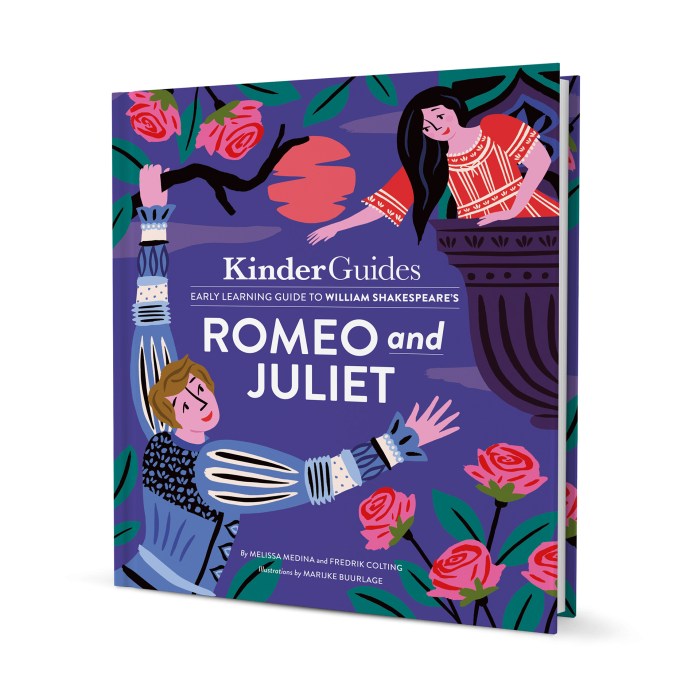
The ABC book is designed with a logical and engaging structure, making it easy for readers to navigate and learn about the play.
The content is organized alphabetically, with each letter of the alphabet representing a term, character, or event from Romeo and Juliet. This alphabetical structure provides a clear and accessible framework for exploring the play’s key elements.
Designating Pages
Each letter of the alphabet is assigned a specific page or section within the book. This dedicated space allows for in-depth exploration of each term, character, or event, providing readers with a comprehensive understanding of the play.
Illustrations and Visuals
To create a visually engaging and comprehensible ABC book on Romeo and Juliet, incorporating a variety of illustrations and visual elements is essential.
These illustrations can range from character portraits to scene depictions, capturing the essence of the play’s characters and settings. For instance, an illustration for the letter “R” could feature a portrait of Romeo, his facial expression conveying the turmoil and passion he experiences throughout the story.
Visual Elements
Beyond illustrations, visual elements such as color, typography, and layout play a crucial role in enhancing understanding and creating an engaging experience.
Color can be used to evoke emotions and set the tone of the story. For example, warm colors like red and orange can be employed to represent the intensity of Romeo and Juliet’s love, while cool colors like blue and green can convey the somber and tragic aspects of the play.
Typography, the art of arranging and designing text, can be used to emphasize certain words or phrases and guide the reader’s eye through the book. Different fonts and sizes can be used to create a visual hierarchy, making key information stand out.
Finally, the layout of the book, including the placement of illustrations and text, can impact the reader’s experience. A well-designed layout can make the book easy to navigate and visually appealing, encouraging readers to engage with the content.
Language and Tone
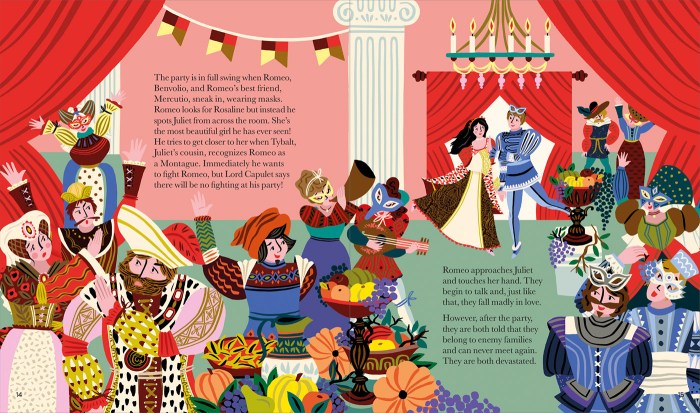
The language and tone of the ABC book should be accessible and engaging for young readers. Simple language, clear explanations, and age-appropriate examples will help ensure that the content is both informative and enjoyable.
The tone of the book should be light-hearted and fun, while still respecting the tragic nature of the story. The book should avoid using overly complex language or mature themes that may not be appropriate for young readers.
Simple Language
The book should use simple language that is easy for young readers to understand. Avoid using complex vocabulary or jargon that may not be familiar to children.
The ABC book for Romeo and Juliet is a great resource for students learning about the classic play. It provides a comprehensive overview of the characters, plot, and themes of the play in an engaging and easy-to-understand format. For a similar approach to another literary work, check out the westing game jake wexler . The ABC book for Romeo and Juliet is a valuable tool for any student studying the play.
Clear Explanations
The book should provide clear explanations of the events and characters in the story. Avoid using vague or ambiguous language that may confuse young readers.
Age-Appropriate Examples
The book should use age-appropriate examples to help young readers understand the story. For example, the book could compare Romeo and Juliet’s love to the love between two friends.
Interactive Elements: Abc Book For Romeo And Juliet
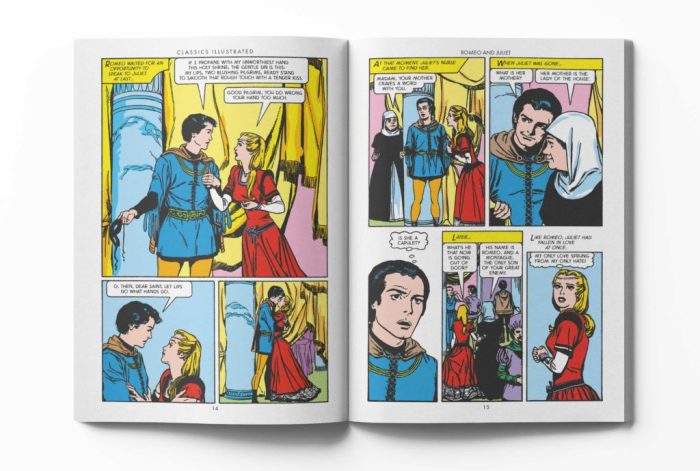
Interactive elements can transform the Romeo and Juliet ABC book into an engaging and immersive experience for young readers. These elements can foster a deeper understanding of the play’s characters, themes, and plot.
Incorporating activities, games, and puzzles related to the play can provide opportunities for hands-on learning and reinforce key concepts. Interactive elements can also cater to different learning styles and make the learning process more enjoyable.
Activities
- Character Profiles:Create activity sheets where children can draw and describe different characters from the play, highlighting their key traits and motivations.
- Scene Reenactments:Encourage children to act out iconic scenes from the play, fostering their understanding of the characters’ interactions and the plot’s progression.
- Timeline Creation:Have children create a timeline of the play’s events, sequencing the key moments and understanding the cause-and-effect relationships.
Games
- Character Match-Up:Design a game where children match character names with their descriptions or quotes, testing their knowledge of the play’s characters.
- Plot Sequence Bingo:Create a bingo board with key events from the play, and have children mark off the events as they read or listen to the story, reinforcing the plot structure.
- Theme Scavenger Hunt:Hide clues related to the play’s themes throughout a room or outdoor area, and have children search for them, fostering their comprehension of the play’s underlying messages.
Puzzles
- Word Searches:Include word searches with vocabulary related to the play, such as characters, settings, and key concepts, expanding their familiarity with the play’s language.
- Crosswords:Design crossword puzzles with clues related to the play’s characters, plot, and themes, challenging children’s knowledge and critical thinking skills.
- Anagrams:Create anagram puzzles using key phrases or character names from the play, encouraging children to unscramble the letters and solve the puzzle.
Educational Applications
An ABC book on Romeo and Juliet offers a unique and engaging way to introduce young learners to the classic play. It provides a foundation for literacy, language development, and cultural understanding.
The book’s simple and accessible format, with one letter and word per page, allows early readers to build their vocabulary and develop phonemic awareness. The familiar characters and story engage children, making the learning process enjoyable and meaningful.
Literacy
- Vocabulary Expansion:Introduces key terms and concepts related to the play, such as “feud,” “love,” and “tragedy.”
- Letter Recognition and Phonemic Awareness:Focuses on one letter and word per page, helping children associate sounds with letters.
- Print Awareness:Encourages children to recognize and manipulate print, fostering an early understanding of how books work.
Language Development
- Oral Language:Prompts children to discuss the characters, plot, and themes of the play, developing their oral communication skills.
- Narrative Comprehension:Introduces the basic elements of storytelling, such as character, setting, and conflict, improving children’s ability to understand and retell stories.
- Figurative Language:Exposes children to literary devices such as metaphors and similes, enriching their language and understanding of figurative speech.
Cultural Understanding, Abc book for romeo and juliet
- Historical Context:Provides a glimpse into the social and historical context of the play, introducing children to Elizabethan England and its customs.
- Literary Appreciation:Fosters an appreciation for classic literature and introduces children to one of the greatest love stories ever written.
- Cross-Cultural Connections:Explores universal themes of love, loss, and the power of fate, connecting children to diverse cultures and experiences.
Historical and Cultural Context
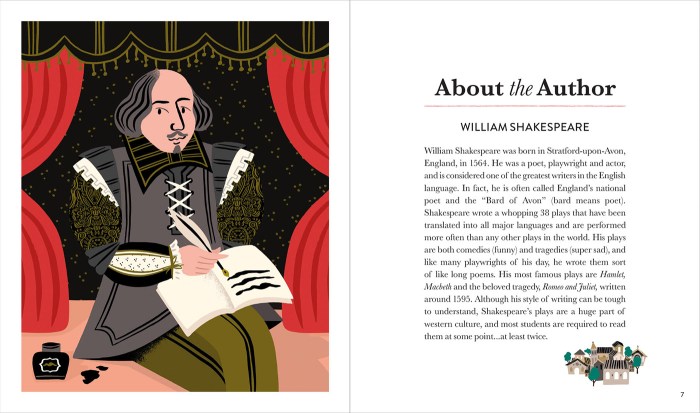
Shakespeare’s Romeo and Julietis a timeless tragedy that explores the themes of love, fate, and the consequences of impulsive actions. Set in the vibrant city of Verona during the Italian Renaissance, the play reflects the social, political, and cultural landscape of the era.
Significance of the Play
Romeo and Julietis widely regarded as one of the greatest love stories ever written. Its enduring appeal stems from its universal themes, relatable characters, and exploration of the complexities of human nature. The play has been translated into over 100 languages and adapted into numerous films, stage productions, and operas.
ABC Book as a Contextual Tool
This ABC book provides a unique way to engage young readers with the historical and cultural context of Romeo and Juliet. By exploring key concepts and themes through the alphabet, readers can gain a deeper understanding of the play’s setting, characters, and social commentary.
Design and Layout
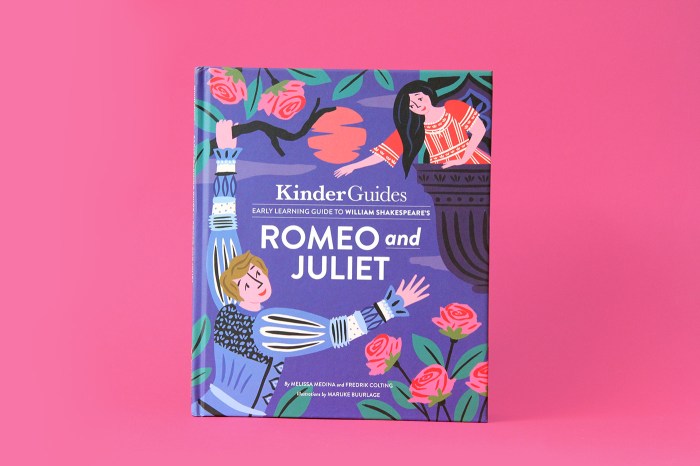
The Romeo and Juliet ABC book is designed to be visually appealing and functional. The layout is organized into sections or chapters, with clear headings, subheadings, and page numbers for easy navigation.
Organization
The book is divided into the following sections:
- The Alphabet
- The Characters
- The Story
- The Themes
Questions and Answers
What is the purpose of an ABC Book for Romeo and Juliet?
An ABC Book for Romeo and Juliet aims to introduce young readers to the play’s characters, themes, and language in an engaging and accessible way.
What age group is the book suitable for?
The book is designed for children ages 5-8, providing a foundation for their literary journey and fostering a love of Shakespeare’s works.
How does the book incorporate interactive elements?
The book includes interactive activities such as puzzles, games, and discussion questions, encouraging children to engage with the text and deepen their understanding of the play.